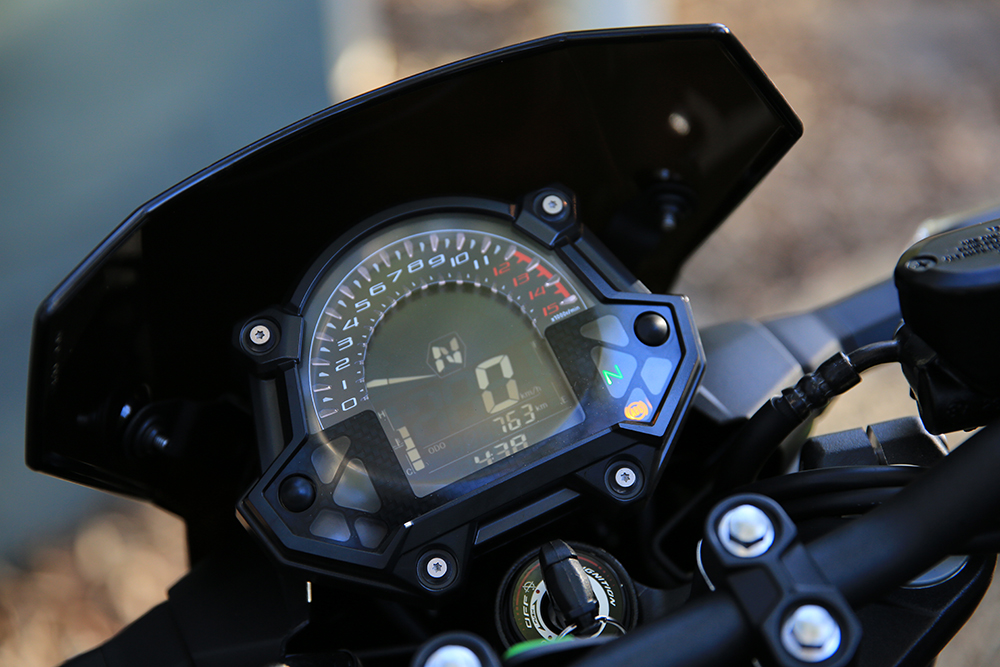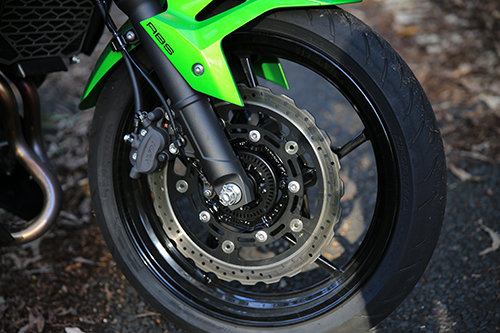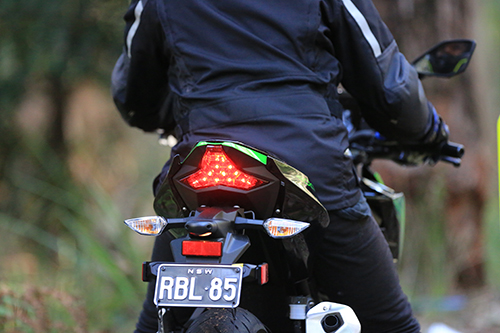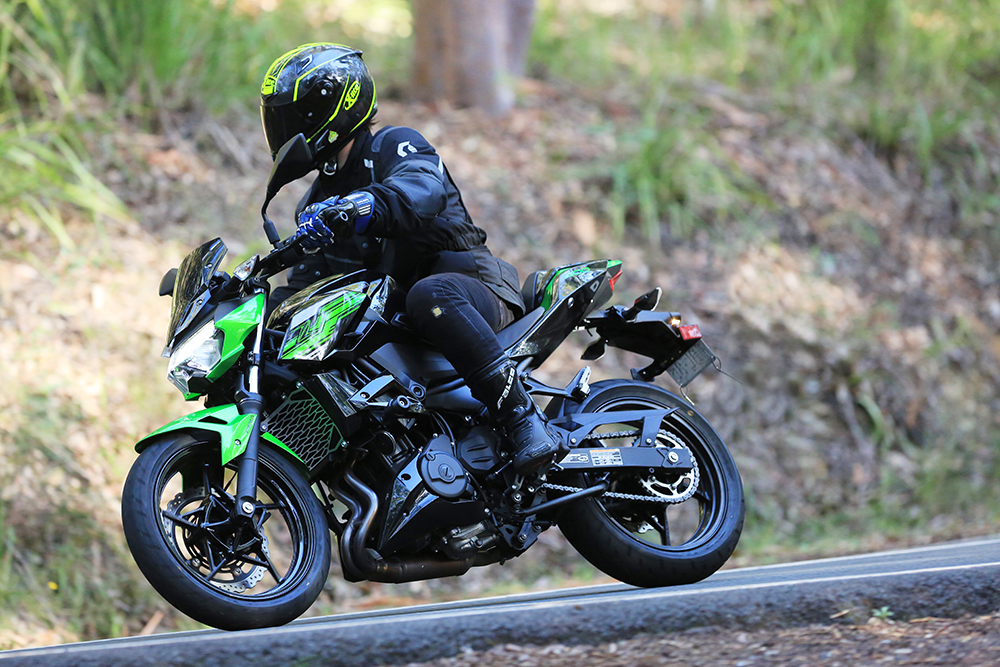The dilemma I have with LAMS bikes is balancing expectations and capabilities. I started my riding career on a racetrack, so now as a restricted licence holder, I often struggle to find a roadbike that can match my ability while still satisfying my performance expectations.
On my way to collect Kawasaki’s new-for-2019 Z400, I opted to not look up the difference in output the extra 103 cubic centimetres makes over its Z300 predecessor, thus in part reducing those pesky expectations. And although 103 cubes doesn’t actually sound like much, it’s almost a 35 percent hike in capacity over its 2018 counterpart, achieved via an increase in bore and stroke from 62mm x 49mm to 70mm x 51.8mm.
The increase was obvious. The extra drive from low in the rev range right through to the engine’s 12,0000rpm redline is noticeable. Jetting away from traffic lights was so much easier due to the extra 11Nm (claimed) of torque – 20 percent more – taking the maximum output to 38Nm which chimes in 2000rpm earlier than last year’s Z300. And it’s the torque that is the important bit here, because the 35 percent capacity hike only results in a 10 percent increase in power, which in real terms is just 3.7kW.

Either way, it’s a small but significant boost to what’s a small but significant bike in the Japanese firm’s line-up, and it makes me wonder if other manufacturers might follow suit. Although, considering at the time of writing, the fully-faired version – the Ninja 400 – is currently taking up five of the top eight positions in the hugely important World Supersport300 championship, it’s probably a no brainer.
It’s a clever move by Kawasaki. It’s considerably better than its predecessor, but not in a way that it poses any concerns to the firm’s 650cc LAMS offerings. It sits very comfortably on the line of being a non-intimidating LAMs bike but, for those who want to, still has an impressive amount of both power and handling abilities to hone skills through your local twisties. And the predictable and linear power delivery gives you a wide band to play with, so you won’t find yourself dancing up and down the gearbox to ensure you’re getting the most from the relatively high-revving parallel-twin.
Like the model it replaces, the Z400 employs a slipper and assist clutch, which is a boon for learners yet to front up to their Motorcycle Operator Skills Test to gain their P-plates. Trust me, I know, I may or may not have failed this in my first attempt.

Kawasaki claims a 20 percent lighter lever pull with a broader engagement range. So in a bid to fully test the bike (or maybe to settle a few internal demons), I decided to put myself through the nerve-racking MOST test again, this time on the Z400 (and maybe this time I performed it in a deserted car park not far from my home…)
With one of the lightest levers I’ve used and one of the most predictable actuations going, I aced both the u-turn and the 90-degree turn with space to spare. Where the hell was this bike when I went for my P-plates?
While mechanically the Z400 is a naked Ninja 400, sharing the same engine, chassis and wheels as it’s fully clothed counterpart, Kawasaki has redesigned the lower-capacity Zed range to bring it into line with their larger-capacity siblings. It’s angular and aggressive and, in my opinion, looks the best in the Kawasaki green colour scheme, or Candy Lime green in Kawasaki speak. In fact, when I was wheeling the bike out of my garage one morning, a well-meaning neighbour of mine asked me if I was allowed to ride the Z400 on my P-plates. It’s a good feeling.
But it’s not all just more go and show for the new Zed, because it benefits from the all-new chassis developed for the Ninja 400 sportsbike. A high-tensile steel tubular trellis frame now replaces the Z300’s steel-tube diamond affair and uses the engine as a stressed component. Matched now to a longer swingarm, though with a shorter overall wheelbase, that means a sharper-steering bike that offers more stability to the rider – good traits for its targeted learner rider.
At 167kg (kerb), the new Z400 weighs three kilograms less than the outgoing Z300, due in part by the chassis update and also due to a smaller capacity fuel tank, which has been reduced from 17 litres to 14.
Suspension is by way of a right-way up, non-adjustable fork which, at 41mm in diameter, are four millimetres larger than the Z300’s fork legs. It’s matched to a monoshock at the rear which is adjustable only for preload.
At some point you’ll want to come to a stop. The ABS-equipped braking package consists of a single 310mm petal front disc (which is up from the 300’s 286mm unit) gripped by a dual piston caliper up front, while a 220mm disc and dual piston caliper handle the rear. And the ABS unit itself is also more compact and slightly better spec than previously. The front end gives you all the confidence and feedback to allow you to brake deep into a corner, and there’s more than enough feel from the rear.

Unfortunately, the Z400 is not quite perfect. The new LCD dash is hugely informative and rather good looking with its central digital speedo flanked by warning and indicator lights and topped by a tacho over the lot, but it’s nigh-on impossible to read once the sun hits it. Not good.
What is pretty good is that the capacity, performance, styling and tech updates come at a mere $300 premium over the 2018 Z300. With a price tag of $6299 (plus-on road costs) and, considering the bike has very few direct competitors in terms of cubes in the nakedbike sector, there’s no reason why it won’t be as successful as its 250cc and 300cc predecessors.



Test Zane Dobie Photography Impact Photography











